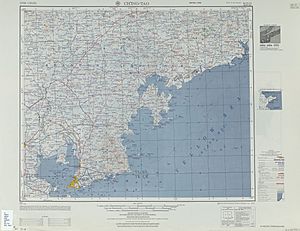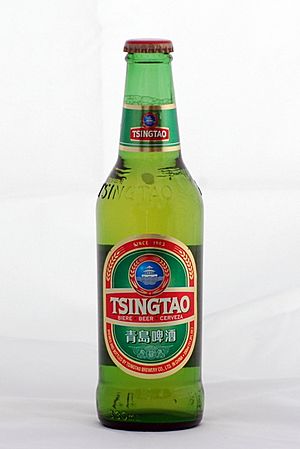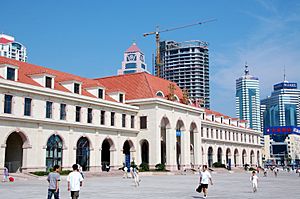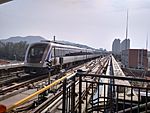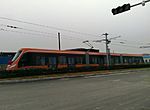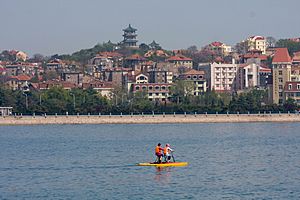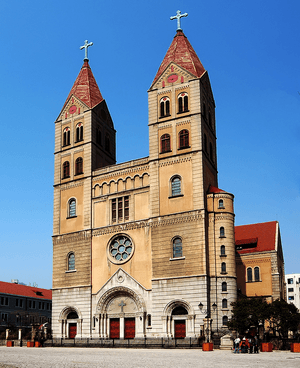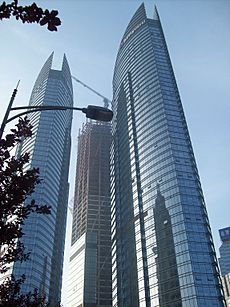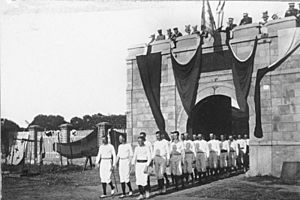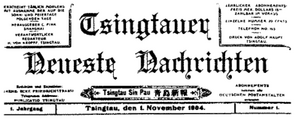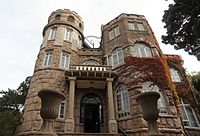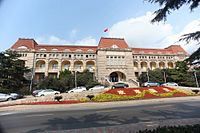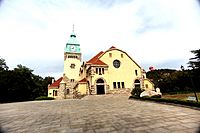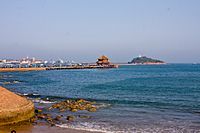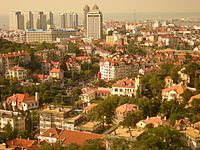Qingdao facts for kids
Quick facts for kids
Qingdao
青岛市
|
|
|---|---|
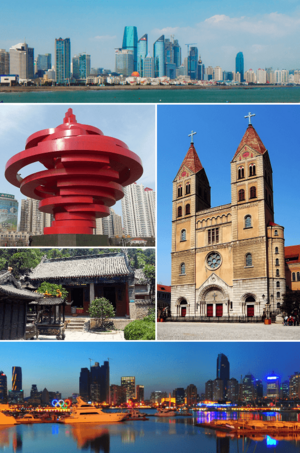 |
|
| Province | Shandong |
| Population
(2010 census)
|
|
| • Total | 8,715,087 |
| Postal code |
266000
|
Qingdao is a major city in the east of Shandong Province on China's Yellow Sea coast. It is also a major nodal city of the One Belt, One Road (OBOR) Initiative that connects Asia with Europe. It has the highest GDP of any city in the province. Administered at the sub-provincial level, Qingdao has jurisdiction over six districts and four county-level cities. As of 2014[update], Qingdao had a population of 9,046,200 with an urban population of 6,188,100. Lying across the Shandong Peninsula and looking out to the Yellow Sea, it borders Yantai to the northeast, Weifang to the west and Rizhao to the southwest.
Qingdao is a major seaport, naval base, and industrial centre. The world's longest sea bridge, the Jiaozhou Bay Bridge, links the main urban area of Qingdao with Huangdao district, straddling the Jiaozhou Bay sea areas. It is also the site of the Tsingtao Brewery, the second largest brewery in China.
In 2018, Qingdao ranked 31st in the Global Financial Centres Index published by the Z/Yen Group and China Development Institute, the other Chinese cities on the list being Hong Kong, Shanghai, Beijing, Shenzhen, Guangzhou, Tianjin, Chengdu, Hangzhou and Dalian. In 2007, Qingdao was named as one of China's top ten cities by the Chinese Cities Brand Value Report, which was released at the 2007 Beijing Summit of China Cities Forum. In 2009, Qingdao was named China's most livable city by the Chinese Institute of City Competitiveness. In 2018, Qingdao held the Shanghai Cooperation Organization summit.
Contents
Geography
| Weather chart for Qingdao | |||||||||||||||||||||||||||||||||||||||||||||||
|---|---|---|---|---|---|---|---|---|---|---|---|---|---|---|---|---|---|---|---|---|---|---|---|---|---|---|---|---|---|---|---|---|---|---|---|---|---|---|---|---|---|---|---|---|---|---|---|
| J | F | M | A | M | J | J | A | S | O | N | D | ||||||||||||||||||||||||||||||||||||
|
11
3
-3
|
14
5
-1
|
22
9
3
|
29
15
8
|
62
21
14
|
74
24
18
|
149
27
22
|
150
28
23
|
72
26
19
|
40
20
14
|
29
13
6
|
12
6
-0
|
||||||||||||||||||||||||||||||||||||
| temperatures in °C precipitation totals in mm source: CMA |
|||||||||||||||||||||||||||||||||||||||||||||||
|
Imperial conversion
|
|||||||||||||||||||||||||||||||||||||||||||||||
Qingdao is located on the south facing coast of the Shandong Peninsula (German: Schantung Halbinsel). It borders three prefecture-level cities, namely Yantai to the northeast, Weifang to the west, and Rizhao to the southwest. The city's total jurisdiction area occupies 10,654 square kilometres (4,114 sq mi), and stretches in latitude from 35° 35' to 37° 09' N and in longitude from 119° 30' to 121° 00' E. The populated sections of the city are relatively flat while mountains spur up within city limits and nearby. The highest elevation in the city is 1,133 metres (3,717 ft) above sea level. Of the total area of Qingdao, 15.5% is highland, while the foothill, plain and lowland areas constitute 25.1%, 37.8% and 21.7%. The city has a 730.64 kilometres (454.00 mi) coastline. Five significant rivers that flow for more than 50 kilometres (31 mi) can be found in the region.
Climate
Qingdao has a temperate, four-season, monsoon-influenced climate that lies in the transition between the humid subtropical (Köppen Cwa) and humid continental (Köppen Dwa) regimes, but favouring the former. Winter is cool to cold and windy, but generally dry, with a January average of −0.2 °C (31.6 °F). Summer is generally hot and humid, but very hot days are rare, with an August average of 25.4 °C (77.7 °F). Due to its proximity to the coast and being on a peninsula, it experiences a one-month delayed spring compared to most inland areas of China, and the annual diurnal temperature variation is only 6.3 °C (11.3 °F). Conversely, autumn is milder than inland areas in Shandong. The water temperature peaks at about 25 °C (77 °F) in late August, with swimming possible two months on either side. The annual mean temperature is 13.0 °C (55.4 °F). Extremes since 1951 have ranged from −15.5 °C (4 °F) on 16 January 1958 to 38.9 °C (102 °F) on 15 July 2002.
During the summer months, the beaches of Qingdao are afflicted by massive algal blooms. The decomposing algae release large amounts of hydrogen sulfide gas, which gives off the odour of rotten eggs. The blooms of sea lettuce, which are partially caused by seaweed farming in Jiangsu Province, led local officials to declare a "large-scale algae disaster" in 2013.
| Climate data for Qingdao (1981–2010 normals) | |||||||||||||
|---|---|---|---|---|---|---|---|---|---|---|---|---|---|
| Month | Jan | Feb | Mar | Apr | May | Jun | Jul | Aug | Sep | Oct | Nov | Dec | Year |
| Record high °C (°F) | 12.9 (55.2) |
19.6 (67.3) |
21.5 (70.7) |
25.2 (77.4) |
34.2 (93.6) |
34.4 (93.9) |
37.4 (99.3) |
34.3 (93.7) |
33.2 (91.8) |
28.4 (83.1) |
22.1 (71.8) |
16.2 (61.2) |
37.4 (99.3) |
| Average high °C (°F) | 3.1 (37.6) |
5.3 (41.5) |
9.4 (48.9) |
15.3 (59.5) |
20.7 (69.3) |
24.0 (75.2) |
27.3 (81.1) |
28.4 (83.1) |
25.5 (77.9) |
20.1 (68.2) |
12.6 (54.7) |
5.8 (42.4) |
16.5 (61.6) |
| Daily mean °C (°F) | −0.2 (31.6) |
1.6 (34.9) |
5.6 (42.1) |
11.3 (52.3) |
16.7 (62.1) |
20.5 (68.9) |
24.4 (75.9) |
25.4 (77.7) |
22.0 (71.6) |
16.5 (61.7) |
9.2 (48.6) |
2.5 (36.5) |
13.0 (55.3) |
| Average low °C (°F) | −2.9 (26.8) |
−1.2 (29.8) |
2.8 (37.0) |
8.3 (46.9) |
13.7 (56.7) |
18.2 (64.8) |
22.4 (72.3) |
23.1 (73.6) |
19.3 (66.7) |
13.5 (56.3) |
6.2 (43.2) |
−0.2 (31.6) |
10.3 (50.5) |
| Record low °C (°F) | −14.3 (6.3) |
−12.1 (10.2) |
−6.2 (20.8) |
−1.6 (29.1) |
6.1 (43.0) |
12.0 (53.6) |
13.6 (56.5) |
16.3 (61.3) |
10.1 (50.2) |
1.9 (35.4) |
−7.2 (19.0) |
−11.3 (11.7) |
−14.3 (6.3) |
| Average precipitation mm (inches) | 11.2 (0.44) |
13.5 (0.53) |
22.4 (0.88) |
28.5 (1.12) |
61.9 (2.44) |
74.3 (2.93) |
148.6 (5.85) |
150.2 (5.91) |
72.4 (2.85) |
39.7 (1.56) |
29.3 (1.15) |
12.1 (0.48) |
664.1 (26.14) |
| Average precipitation days (≥ 0.1 mm) | 3.1 | 3.7 | 4.7 | 6.7 | 7.5 | 9.4 | 12.4 | 10.2 | 6.5 | 6.1 | 4.7 | 3.4 | 78.4 |
| Average relative humidity (%) | 63 | 64 | 66 | 68 | 72 | 82 | 87 | 82 | 71 | 65 | 64 | 63 | 71 |
| Mean monthly sunshine hours | 186.0 | 180.8 | 220.1 | 222.0 | 244.9 | 219.0 | 182.9 | 223.2 | 219.0 | 220.1 | 189.0 | 182.9 | 2,489.9 |
| Percent possible sunshine | 60 | 59 | 60 | 56 | 56 | 50 | 41 | 53 | 59 | 63 | 61 | 61 | 57 |
| Average ultraviolet index | 2 | 3 | 5 | 7 | 9 | 9 | 10 | 9 | 7 | 5 | 3 | 1 | 6 |
| Source: China Meteorological Administration, China Weather (precipitation days 1971–2000),, Hong Kong Observatory (sun only, 1961–1990) and Weather Atlas (UV index) | |||||||||||||
Demographics
| Historical population | ||
|---|---|---|
| Year | Pop. | ±% |
| 1913 | 58,000 | — |
| 1953 | 916,846 | +1480.8% |
| 1964 | 1,383,433 | +50.9% |
| 1982 | 4,227,594 | +205.6% |
| 1990 | 6,663,989 | +57.6% |
| 2000 | 7,494,194 | +12.5% |
| 2010 | 8,715,100 | +16.3% |
| Population size may be affected by changes on administrative divisions. | ||
By the end of 2006, Qingdao was estimated to be the home of about 8 million inhabitants, of which around 3 million reside in the Qingdao urban area. Another estimated 5 million live in other cities under Qingdao's jurisdiction. The annual birth rate is calculated around 76,507, with a birth rate of 10.15 per year per thousand, and a death rate of 6.32, both calculated on an annual basis. Living standards are among the highest of leading Chinese cities due to the strong export economy and relatively high family wages.
Qingdao is home to 38 Chinese ethnic minorities, which account for 0.14% of the city's total population.
There is a large Korean community in Qingdao. By 2009, there were approximately 100,000 Koreans working, studying and living in Qingdao, which makes Qingdao the second in terms of Korean population in China, following Beijing which has about 200,000 Koreans.
Economy
An important region in Eastern China, Shandong Province has seen substantial change in its economic landscape in recent years. Much of this development has been concentrated in Qingdao. Qingdao has seen rapid development. With an annual growth rate of 18.9 percent in 2006, the city's GDP reached 42.3 billion, ranking first in Shandong Province and tenth out of China's top 20 cities. GDP per capita comprised ¥52,895 (US$7,616) in 2008. The GDP has grown steadily at an average pace of 16% annually. In 2006, Qingdao was ranked one of six "golden cities" by the World Bank, out of 120 Chinese cities assessed on factors including investment climate and government effectiveness.
Internationally, Qingdao is perhaps best known for its Tsingtao Brewery, founded by a German-British joint venture in 1903 that produces Tsingtao beer, the best-known Chinese export beer. It is also home to Haier, a large white goods manufacturer, and Hisense, a major electronics company. In 2002 guitar manufacturers Epiphone opened a factory in Qingdao.
In 1984 the Chinese government named a district of Qingdao a Special Economic and Technology Development Zone (SETDZ). Along with this district, the entire city had gone through amazing development of secondary and tertiary industries. As an important trading port in the province, Qingdao flourishes with foreign investment and international trade. South Korea and Japan in particular made extensive investment in the city. Approximately 80,000 South Korean citizens reside there.
In terms of primary industry, Qingdao has an estimated 50,000 acres (200 km2) of arable land. Qingdao has a zigzagging pattern coastline, and thus possesses an invaluable stock of fish, shrimp, and other sea resources.
Qingdao is also home to a variety of mineral resources. Up to thirty different kinds have been mined.
Qingdao's wind power electricity generation performs at among the highest levels in the region.
Industrial zones
- Qingdao Special Economic and Technological Development Area
- Qingdao Free Trade Zone
- Qingdao High-tech Industrial Zone
- Qingdao University Industrial Zone
Transport
Road
There are a total of 1,145 km (711 mi) of roads in the Qingdao area, with nearly 500 km (310 mi) of expressways. These National Trunk Highway System (NTHS) Expressways begin or pass through in Qingdao. Expressways that begin in Qingdao are in Bold:
- G15 Shenhai Expressway (Shenyang, Liaoning-Haikou, Hainan)
- G18 Rongwu Expressway (Rongcheng, Shandong-Wuhai, Inner Mongolia)
- G20 Qingyin Expressway (Qingdao-Yinchuan, Ningxia)
Spur Route: G2011 Qingxin Expressway (Qingdao-Xinhe, Pingdu, Shandong)
These provincial expressways begin in or pass through Qingdao. Expressways that begin in Qingdao are in Bold:
- S16 Rongwei Expressway (Rongcheng-Weifang)
- S19 Longqing Expressway (Longkou-Qingdao)
- S21 Xinwei Expressway (Xinhe-Weifang)
- S24 Weiqing Expressway (Weihai-Qingdao)
Other than Expressways, there are also National Highways that pass through or begin in Qingdao. National Highways that begin in Qingdao are in bold:
- G204 (Yantai-Shanghai)
- G206 (Yantai-Shantou)
- G308 (Qingdao-Shijiazhuang)
- G309 (Rongcheng-Lanzhou)
On June 30, 2011, the longest bridge over water opened in Qingdao. The bridge, Haiwan Bridge, is 26.4 miles (42.5 km) long and connects Qingdao to an offshore island, Huangdao. It would easily cross the English Channel and is almost three miles (4.8 km) longer than the previous record-holder, the Lake Pontchartrain Causeway in the American state of Louisiana. Haiwan Bridge is supported by more than 5,000 pillars and costs about 10 billion yuan which is about 1.5 billion dollars. The bridge was designed by the Shandong Gausu Group and the construction lasted for four years. Haiwan Bridge cut the commute between the city of Qingdao and the sprawling suburb of Huangdao by 30 minutes. At least 10,000 workers toiled in two teams around the clock to build the bridge, which was constructed from opposite ends. On the same day, the Jiaozhou Bay Tunnel opened. The tunnel brought much convenience to people by supporting public buses and making transport between the two areas more convenient.
Marine
Qingdao (official name: Qingdao port international co. ltd.) hosts one of the world's busiest seaports. Cooperative relations have been established with 450 ports in 130 countries worldwide. In 2003, the annual cargo handling capacity exceeded 100 million tons for the first time. The number of containers reached 3.41 million twenty-foot equivalent units (TEU) of cargoes. By 2011, the port had become the world’s sixth-busiest by Total Cargo Volume, having handled 372 million tonnes of cargo in that year. As of 2016, it was the 8th in the world in terms of TEUs (Twenty Foot Equivalent Units).
The Orient Ferry connects Qingdao with Shimonoseki, Japan. There are two ferry lines connecting Qingdao with South Korea. The New Golden Bridge II operates between Qingdao and Incheon, and the Blue Sea Ferry operates between Qingdao and Gunsan.
Qingdao port also includes a number of large adjacent ports including Dongjiakou.
Aviation
The Qingdao Liuting International Airport, 23 km (14 mi) away from city centre, is served by 13 domestic and international airlines, operating 94 routes, 12 of which are international and regional. In 2011, Qingdao Liuting International Airport was the 16th busiest airport in the People's Republic of China with 11,716,361 passengers. A new civil aviation airport with much larger capacities will be built in Jiaozhou District.
Intercity rail
Qingdao's railway development was picked up during the late 1990s. It is at the beginning of the Jiaoji Railway. Qingdao's city proper has some major railway stations, Qingdao Station, Sifang Station, Cangkou Station, Great-Seaport Station, etc.
D and G series High speed trains travel on the Jiaoji High Speed Railway and reach speeds of 300 km/h (190 mph) on the Jinan-Qingdao Section. Services go to Beijing, Shanghai, Hefei, Jinan and Tianjin.
Domestic rail lines connect Qingdao with many cities in China including Beijing, Lanzhou, Chengdu, Xi'an, Zhengzhou, Jinan and Jining.
Public transport
Qingdao's public traffic owns 5283 large and medium-sized buses, CNG buses as of 2012[update].There are also 136 trolleybuses as of 2012[update]. All of the buses and trolleybuses can be accessed using the Qingdao Public Traffic IC Card (青岛卡), which uses radio frequencies so the card does not have to physically touch the scanner. Non air-conditioned busses cost 1 yuan, The volume of road passenger transport approaches 0.8 billion per year. The Public Transport Brand of 'Ri-Xin Bus (日新巴士)' is also known in China.
There are a number of taxi companies in Qingdao including Yiqing Company, Zhongqing Company, Jiaoyun Company and, Huaqing Company.
Subway
After getting the approval from the State Council, the government announced on 18 August 2009 that Qingdao is ready to spend more than 29 billion yuan ($4.2 billion) before 2016 on its subway construction. Construction of 54.7 km (34.0 mi) of subway line 3 was completed before 2016 with a total investment of 29.2 billion yuan ($4.3 billion). Metro Line 3 is the first line in function and opened on 16 December 2015. In the long term, the city plans to build eight subway lines in downtown and some suburban districts, which account for 231.5 km (143.8 mi) in future. As of end of May 2018, the system has an operating length of 170 km (110 mi), lines in operation including Line 2, Line 3, Line 11, and Line 13.
Tramway
Qingdao Tram, is a tram system operating in Chengyang District, Qingdao, China. It opened in 2016. The Qingdao Public Transport Group Rail Bus Co., Ltd. is responsible for operation and management.
Military
Qingdao is headquarters of the North Sea Fleet of the People's Liberation Army Navy.
Culture
Architecture
There is a large number of German-style buildings in Qingdao city centre, remarkable considering the German colonial period only lasted 16 years (1898–1914). The unique combination of German and Chinese architecture in the city centre, combined with German demographic roots and a large Korean expatriate population, gives Qingdao a distinct atmosphere. An old saying described Qingdao as a city of "red tiles green trees, blue sky and blue sea." This saying indeed gives a picture of bird view of Qingdao. A larger number of areas in former foreign styles are well preserved. Although the new city area is under large-scale reconstruction, the old city area (especially the western part of Shinan District) still retains many traditional buildings.
Notable people
- Ma Jian (马建)
- Xiao Hong (萧红)
- Xiao Jun (萧军)
- Duanmu Hongliang (端木蕻良)
- Erin Pizzey, (was born in Qingdao)
- Sun Li (孙犁)
- Li Zhaoxing (李肇星)
- Zhang Ruimin (张瑞敏)
- Victoria Song (宋茜, f(x))
- Huang Zitao (黄子韬, musician,actor)
- Huang Bo (黄渤)
- Zhang Jike (张继科)
- Gao Fenghan (高凤翰)
- Toshiro Mifune (was born in Qingdao)
- Li Cunxin (李存信)
- Huang Xiaoming (黄晓明)
- Chen Hao (陈好)
- Xia Yu (夏雨)
- Fan Bingbing (范冰冰,was born in Qingdao)
- Bai Baihe (白百合)
- Hao Haidong (郝海东)
- Wang Dong (王栋, Chinese Footballer)
- Zhang Juanjuan (张娟娟,archer)
- Malcolm H. Wiener, (was born in Qingdao)
- Ni Ping (倪萍)
- Tang Guoqiang (唐国强)
Movies shot in Qingdao
- A Better Tomorrow 2018 (英雄本色2018)2016
- The Great Wall (长城) 2016
- Underdog Fight (硬汉) 2008
- Underdog Fight II (硬汉 II) 2013
- Ocean Heaven (海洋天堂) 2010
- Beauty Remains (美人依旧) 2005
Language
During the city's colonial days, German was the official language and rigorously taught and promoted. Since the demise of Germany's colonial empire during World War I, the German language is all but gone, leaving little impact on the local languages. A local accent known as Qingdao dialect (青岛话, pinyin qingdao hua) distinguishes the residents of the city from those of the surrounding Shandong province. Due to the efforts by the city government to promote standard Mandarin, most educated people can speak standard Mandarin in addition to their native dialect. With reform policies and English teaching, some young citizens have been taught English and many can converse with English-speaking foreigners. Business and traffic signs in English are becoming more and more common.
Cuisine
Seafood is a typical delicacy of the coastal city, divided into two categories: "Great Seafood" including sea cucumbers, abalones, shark's fin, prawns, crabs, conch, and some big fish, and "Little Seafood" comprising squid, shrimps, octopus, oysters, razor clams, clams, periwinkles, yellow croakers, etc.
The distinctive cuisine of the area is Lu Cai, the Shandong regional style.
Festivals
Notable festivals include:
- Qingdao International Horticultural Exposition 2014 is the biggest international fair that has been held in the history of the city.
- Qingdao International Beer Festival(青岛国际啤酒节) in August/September, held annually since 1991
Media
Qingdao previously had a large German community and a German garrison, so three German newspapers operated in Qingdao. German papers included Deutsch-Asiatische Warte (T: 泰東古今鑑, S: 泰东古今鉴, P: Tàidōng Gǔjīn Jiàn; weekly newspaper published until 1906, included Die Welt des Ostens, Altes und Neues aus Asiens drei Kaiserreichen, a cultural supplement), the Tsingtauer Neueste Nachrichten and the Kiautschou Post (a daily paper published from 1908 to 1912, referring to the Kiautschou (Jiaozhou) Bay concession). German publishing in Qingdao ended after World War I and the beginning of the Japanese administration.
A 1912 publication of the United States Department of Commerce, Bureau of Foreign and Domestic Commerce said that the Tageblatt für Nordchina of Tianjin was read in Qingdao, and that major newspapers from Shanghai were also read in Qingdao.
Tourism
Qingdao attracts many tourists due to its seaside setting and temperate weather. Parks, beaches, sculptures and unique German and modern architecture line the shore. The central tourist information, the Qingdao Information Centre for International Visitors, is located on Middle Hong Kong Road (香港中路).
Qingdao's major attractions include:
Western Shinan district
- Zhan Qiao (Pier, 栈桥)
- Little Qingdao Isle (小青岛)
- Tian Hou Temple (天后宫), Qingdao Folk Museum
- Ba Da Guan (Eight Great Passes, 八大关), the older area of town with some surviving German and Japanese architecture.
- Lu Xun Park, named after Lu Xun (鲁迅), modern Chinese writer and critic, who lived and taught in the 1930s.
- Zhongshan Park, named after the style name 'Zhongshan' of Sun Yat-sen (孙文,字中山), a famous modern Chinese politician.
- Xiao Yu Shan (Little Fish Hill, 小鱼山)
- The twin-spired St. Michael's Cathedral (Kathedrale St. Michael) (天主教堂), one piece of the famous Neo-romanesque architecture in Qingdao, designed by German architect Alfred Fräbel, completed in 1934.
- Qingdao Aquarium (青岛水族馆)
- Jiaozhou Governor's Hall (提督府), office building of former German governors (Gouverneurspalast) and former municipal government
- Xinhao Hill (信号山)
- Photographs of Historic Euro-Asian Area
Eastern Shinan district
- May Fourth Square (Platz des vierten Mai), Coastal plaza with the Wind of May sculpture
- Tsingtao Brewery (Tsingtao-Brauerei), founded by Germans and the most exported beer from China.
- Zhanshan Temple (Dschanschan-Tempel), Qingdao's oldest Buddhist temple.
Laoshan district (崂山区)
- Lao Shan (Mount Lao, Lauschan, 崂山), 40 km (25 mi) east of Qingdao, the most famous Taoist mountain with Taoist retreat – Great Purity Palace (太清宫).
Other districts of Qingdao
- Jiaozhou Governor's Hall (Gouverneurspalast), former seat of the present and previous two governments.
Images for kids
-
Main gate of former Chinese munitions depot, taken over by the Imperial German Navy, Kiautschou Bay, Shandong peninsula, 1898
See also
 In Spanish: Qingdao para niños
In Spanish: Qingdao para niños


